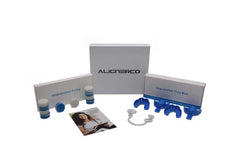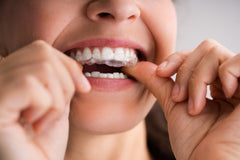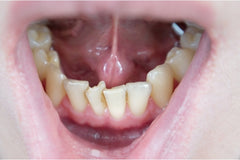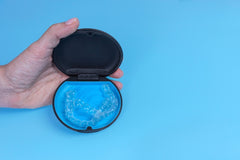An overbite can affect both the function of your mouth and your general health, not just your discomfort level. Moreover, it may alter the way you picture yourself because of the way your mouth appears. In this blog post, we can examine how clear aligners correct the overbite.
Table of contents
What is an Overbite?
Overbiting is a very common stage of human growth. Most people have a modest overbite, which helps us to chew food efficiently of all kinds. However, occasionally, a person's upper teeth may protrude beyond what is necessary. This is the point where overbite correction with aligners is needed.
The orthodontic term for this is malocclusion. Malocclusion is the simple term for slightly misaligned teeth. If they are benign, your orthodontist might not recommend treating them. On other occasions, an adjustment can be necessary. In addition to aesthetics, aligners may be suggested to treat an overbite if you have any of the following symptoms:
- Chewing Issues
- Clenching the jaw
- An overbite that hinders speech if you're having any of the following problems:
Why cause an Overbite?
Poor habits during childhood, when the teeth are still growing and primarily establishing, are often the cause of an overbite. When children's first teeth appear, frequent usage of items like pacifiers might force the teeth to grow outward.
The following are the main reasons for an overbite:
1. Use of a Pacifier
When teeth start to grow, the practice of constantly sucking on a pacifier may result in misalignment. Using a pacifier can increase the chance of developing an overbite in comparison to thumb sucking.
2. Tongue-biting
Adults and children can acquire the habit of placing their tongues in their mouths strangely. This occurs for a variety of reasons.
3. Inherited or genetic
Dental configurations are heritable. Parents who have an overbite may inherit this characteristic.
Clear Aligner: Correct the Overbite
Choosing clear aligners to fix an overbite requires a few crucial procedures to be successful.
First Consultation
The first step in your process is to see your orthodontist. To determine whether you are a good candidate, they will first examine your teeth and general dental health before going over the aligner procedure and what to expect.
Diagnostic Records
Detailed scans and pictures of your teeth will be taken if clear aligners are determined to be a good fit for your overbite. These have two uses: they let you see the possible changes that might bring about and are submitted to the dental lab so professionals can create your personalized plan.
Custom Aligner Creation
Your customized aligner trays are made based on these exact dimensions, guaranteeing that they are made specifically for the structure of your teeth.
Visualizing the Change
You can see a preview of your future smile by using the previously taken photos to illustrate how your teeth will move during treatment.
A Timetable of Treatment
A comprehensive timetable for using your aligners will be provided to you. Under your dentist's supervision, you will wear the initial set of trays for two weeks before switching to the next set in the series to gradually correct the overbite.
Frequent Check-ups
You must see your orthodontist regularly. They can track your progress and verify that clear aligners are successfully correcting your overbite during these appointments.
Under the careful supervision of your orthodontist, completing these steps guarantees a clear route to the smile of your dreams, with each stage intended to bring you one step closer to your objective.
How Overbite Is Fixed with Clear Aligners
It is beneficial for patients with mild to severe overbite problems to use clear aligners. The aligners gradually shift the teeth into the precise alignment position as they are put over the teeth. Every aligner tray is made to exact measurements based on the alignment your teeth require at each appointment with your orthodontist.
To achieve proper alignment, an orthodontist will usually offer you a set of aligner trays that will rotate, move vertically, or move horizontally. Every time you see an orthodontist, these aligners are intended to be somewhat more aligned than your existing teeth alignment.
Your teeth will gradually reposition themselves until they are perfectly aligned. The purpose of each aligner is to assist your teeth in adjusting to the straightening process. A single treatment often requires the use of 20 or more aligners.
How much time does it take?
As dental issues vary, every patient is different. The length of the custom treatment varies from 12 to 18 months, depending on how severe the overbite is. For six months, minor overbites can be treated. Approximately one appointment per six to ten weeks will be required for dental visits.
What to Expect Regarding Clear Aligners
Clear aligners are among the most effective treatments for overbite, and they are also quite easy to use. Making an appointment for an orthodontist consultation should be your first step. In addition to performing a comprehensive examination of your face and mouth, they will ask you several questions about your medical and dental histories. Your orthodontist can get a preliminary sense of what has to be done and to what extent during this examination.
Models and Imaging
After that, your orthodontist could request several X-rays and three-dimensional models of your teeth. This strengthens the orthodontist's plan and adds to the initial impression's detail. If necessary, they may then arrange for a follow-up session or begin adding attachments during that same visit.
Plans of Treatment and Attachments
An overbite can be corrected by aligners with the use of attachments. Attachments are small, tooth-colored bumps that are placed on or behind your teeth to help your overbite straighten itself as the clear aligners push on it.
It doesn't take long to secure them to the teeth, and this is a fundamental aspect of clear aligner technology.
Your orthodontist will go over the path of your clear aligners with you once the attachments are in place. The course of treatment is divided into phases that are specially designed to address your overbite. They are marked with several classes of aligners. As they are clear and roughly shaped like your teeth, these aligners might all have the same appearance. However, there is a noticeable difference if you compare them to how straight the initial and last stages are. To reach the intended destination, each one in between makes very small motions.
Regular Use
To achieve optimal outcomes from your clear aligners, you must wear them for a specific amount of time to allow them to properly correct your overbite. According to the advice, you ought to have them for at least 22 of the 24 hours each day. Although the idea is similar to that of braces, you have greater freedom to take them off for brushing your teeth and eating. But this can also make it simple to forget to wear them for the recommended duration of time.
Are You a Good Fit for Aligners?
For adults and teenagers who wish to correct their overbite, clear aligners are the ideal choice. Clear aligners can be the best option for you if you don't feel comfortable wearing braces or if you want to be able to take off your alignment device to eat. With clear aligners, mild to moderate overbites can be easily fixed. Furthermore, they can resolve multiple problems at once. Your orthodontist can schedule the different stages so that a single treatment plan can address several issues.
Let's sum up by saying that clear aligners are a potentially effective way to address overbite, giving patients a discrete, easy, and comfortable way to have a gorgeous, healthy smile.
FAQs
1. Will my speech be affected by clear aligners?
During the first phase of adjustment, some individuals may lisp or have mild speech difficulties. However, when the mouth gets used to wearing the aligners, speaking usually gets better.
2. Can teenagers with overbites use clear aligners?
Yes, teens with overbites may benefit from clear aligners. An orthodontic consultation is required to evaluate the patient's dental needs and developmental stage to choose the best course of action.
3. Are overbites effectively corrected with clear aligners?
It is true that clear aligners, especially in mild to moderate cases, can be quite successful in treating overbites. Severe overbites, however, can call for more orthodontic work.



















